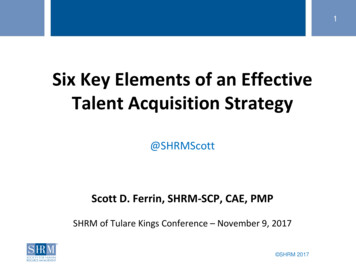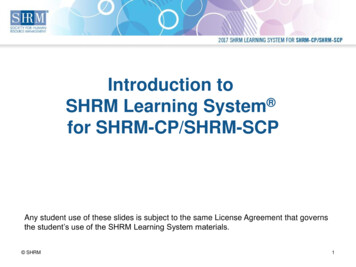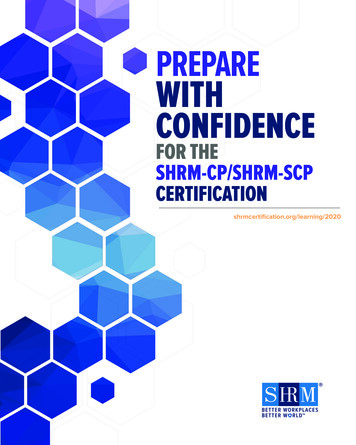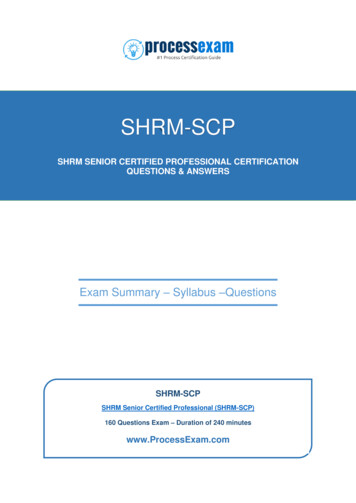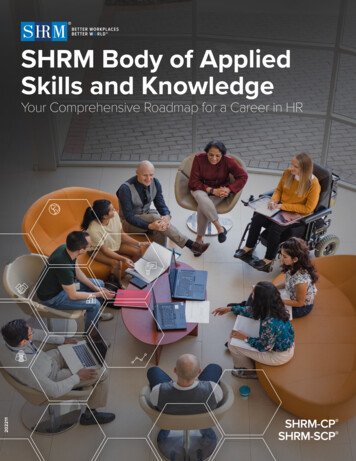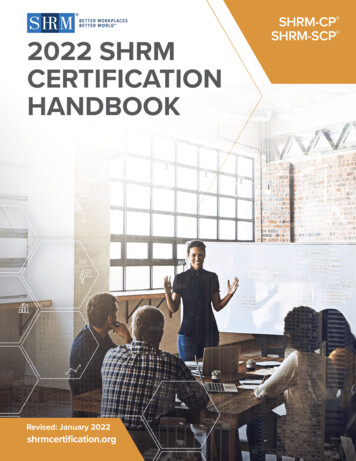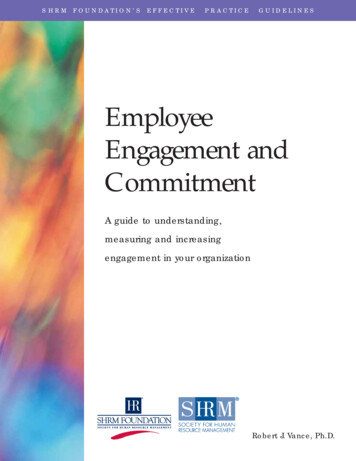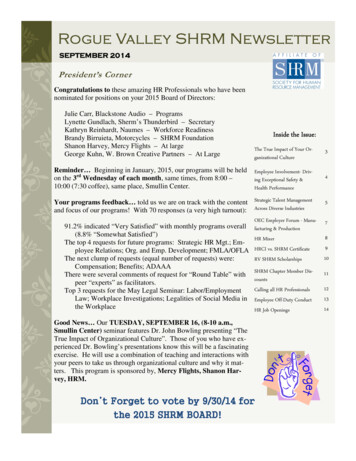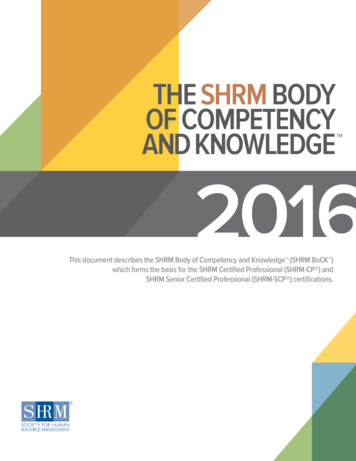
Transcription
THE SHRM BODYOF COMPETENCY AND KNOWLEDGE2016This document describes the SHRM Body of Competency and Knowledge (SHRM BoCK )which forms the basis for the SHRM Certified Professional (SHRM-CP ) andSHRM Senior Certified Professional (SHRM-SCP ) certifications.
THE SHRM BODY OF COMPETENCY AND KNOWLEDGECONTENTSIntroduction to the SHRM Body of Competency and Knowledge. 1Figure 1: The SHRM Body of Competency and Knowledge.2Development of the SHRM BoCK. 3Figure 2: SHRM Competency Model Development. 3Figure 3: Knowledge Specification Process. 3What Are Competencies?.4Figure 4: Competency Definitions.4Organization of the SHRM BoCK Document. 5Section 1: Behavioral Competencies. 6Behavioral Competency #1: Leadership & Navigation.7Behavioral Competency #2: Ethical Practice. 8Behavioral Competency #3: Business Acumen. 9Behavioral Competency #4: Relationship Management. 11Behavioral Competency #5: Consultation. 12Behavioral Competency #6: Critical Evaluation. 13Behavioral Competency #7: Global & Cultural Effectiveness. 14Behavioral Competency #8: Communication.15Section 2: HR Expertise (HR Knowledge). 16What Are HR Functional Areas of Knowledge?.16Figure 5: Knowledge Domains and HR Functional Areas.17DOMAIN 1: People.18Functional Area #1: Talent Acquisition & Retention.18Functional Area #2: Employee Engagement.19Functional Area #3: Learning & Development.21Functional Area #4: Total Rewards.22DOMAIN 2: Organization.23Functional Area #5: Structure of the HR Function.23Functional Area #6: Organizational Effectiveness & Development.24Functional Area #7: Workforce Management.25Functional Area #8: Employee Relations.26Functional Area #9: Technology & Data.28DOMAIN 3: Workplace.29Functional Area #10: HR in the Global Context.29Functional Area #11: Diversity & Inclusion .30Functional Area #12: Risk Management. 3 1Functional Area #13: Corporate Social Responsibility.33Functional Area #14: U.S. Employment Law & Regulations.35DOMAIN 4: Strategy. 37Functional Area #15: Business & HR Strategy. 37Section 3: Exam Overview. 39Figure 6: Score Weighting for Each Domain in the Certification Exams.39References. 40Additional Resources . 41
THE SHRM BODY OF COMPETENCY AND KNOWLEDGEIntroduction to the SHRM Bodyof Competency and Knowledge For more than sixty-five years, the Society forHuman Resource Management (SHRM) has servedthe human resource profession. HR professionalsworldwide look to SHRM for comprehensiveresources to help them function effectively at theirjobs, develop their careers, and partner strategicallywith employers.SHRM also works to advance the HR professionas a whole, ensuring that as business evolves,HR evolves to meet business needs. Increasingly,business understands that effective peoplemanagement is a strategic imperative. As a result,employers expect that HR professionals willdemonstrate, in addition to a thorough knowledgeof HR concepts and requirements, the behavioralcompetencies required to effectively apply thatknowledge in the modern workplace in support oforganizational goals.In 2011, SHRM began years of extensive researchinvolving thousands of HR professionals to developthe SHRM Competency Model, which identifieseight key Behavioral Competencies: Ethical Practice,Leadership & Navigation, Business Acumen,Relationship Management, Communication, Consultation, Critical Evaluation, and Global & CulturalEffectiveness and one Technical Competency: HRExpertise (HR Knowledge) that are the foundationof successful HR practice. The SHRM CompetencyModel provides HR professionals with a comprehensive roadmap for developing the capabilitiesthey need to advance their careers and improvetheir effectiveness in the workplace.two goals: for HR professionals, to reaffirm theimportance of acquiring both the competenciesand knowledge essential for successful jobperformance; and for employers, to provide reliableindicators of proficiency in these critical dualaspects of modern HR practice.SHRM regards the SHRM-CP and SHRM-SCP asthe new standard in certification for the HR profession. By incorporating key HR competencies intothe SHRM-CP and SHRM-SCP, SHRM has enhancedthe relevance of these certifications. SHRM’scredentials demonstrate to the global businesscommunity that the credential holder has strongcapabilities in both aspects of HR practice—competency and knowledge—that are required foreffective job performance.The SHRM Body of Competency and Knowledge (SHRM BoCK ), summarized in Figure 1, also drawsheavily on the SHRM Competency Model. TheSHRM BoCK documents the HR Behavioral Competencies and Knowledge Domains tested on theSHRM-CP and SHRM-SCP certification exams. TheSHRM BoCK is also the common framework for itemwriters developing questions and individuals developing exam preparation materials. SHRM operatesexam development and study material developmentas separate, independent functions, and observes astrict firewall between these activities to protect theintegrity and credibility of the certification exams.The SHRM Competency Model is fundamental toSHRM’s two new certifications, the SHRM CertifiedProfessional (SHRM-CP ) for early-career practitioners, and the SHRM Senior Certified Professional(SHRM-SCP ) for senior-level practitioners. SHRMlaunched these new credentials in 2015 to furtherTHE SHRM BODY OF COMPETENCY AND KNOWLEDGE1
INTRODUCTION TO THE SHRM BODY OF COMPETENCY AND KNOWLEDGEFigure 1: SHRM BODY OF COMPETENCY & KNOWLEDGE (SHRM BOCK)SHRM Body of Competency & Knowledge VALUATIONBEHAVIORAL COMPETENCIESLEADERSHIP &NAVIGATIONRELATIONSHIPMANAGEMENTGLOBAL& CULTURALEFFECTIVENESSCOMMUNICATIONHR EXPERTISE (HR KNOWLEDGE DOMAINS) Structure of theHR Function Org. Effectiveness& Development WorkforceManagement Employee Relations Technology & DataWORKPLACE HR in theGlobal Context Diversity &Inclusion Risk Management Corporate SocialResponsibility Employment Law& Regulations**Applicable only to examinees testing within the U.S.2THE SHRM BODY OF COMPETENCY AND KNOWLEDGESTRATEGY Business& HR StrategyHR FUNCTIONALAREAS Talent Acquisition& Retention EmployeeEngagement Learning &Development Total SFULBUSINESSOUTCOMESEFFECTIVEINDIVIDUALPERFORMANCE
INTRODUCTION TO THE SHRM BODY OF COMPETENCY AND KNOWLEDGEDevelopment of the SHRM BoCKThe SHRM Competency Model, which provides theframework for the SHRM BoCK, was developedusing rigorous job analysis methods with theactive engagement of the global HR community(see Figure 2). SHRM conducted 111 focus groupsinvolving 1,200 HR practitioners to identify ninecritical competencies necessary for success as anHR professional. Focus group participants includedHR professionals from 33 countries, representing adiversity of both personal (e.g., career level, tenure)and organizational (e.g., sector, industry, size)attributes.First, SHRM performed an extensive review of theexisting literature on HR knowledge, includingtextbooks, curricula, syllabi, and other educatorresources, to determine the universe of potentialknowledge areas needed by HR professionals.SHRM also consulted SHRM academic andemployer surveys regarding the basic functionalknowledge needed for participation in the humanresources field. SHRM drew on this research tocreate a preliminary knowledge framework for theSHRM-CP and SHRM-SCP certifications.SHRM then confirmed the importance, relevance,and universality of the SHRM Competency Modelthrough a content validation survey, which drewresponses from more than 32,000 HR professionalsworldwide. Finally, a series of large-scale multi-organizational criterion validation studies, involvinga highly diverse sample of more than 1,500 HRprofessionals and their supervisors, established thatproficiency in these competencies is closely linkedto successful job performance.SHRM conducted a three-part knowledge specification exercise to develop the SHRM BoCK component identifying the key areas of HR functionalknowledge or HR Expertise (HR Knowledge), thesingle technical Competency in the SHRM Competency Model (see Figure 3).SHRM then established a BoCK Advisory Panel tovalidate this framework. This panel included 19 HRand business leaders from various industries including retail, research, consulting, health care, andmanufacturing. The panel reviewed the proposedframework for HR technical knowledge for accuracyand comprehensiveness; defined key responsibilitystatements and knowledge topic areas associatedwith each Knowledge Domain and Functional Area;and developed importance rankings and weights foreach Knowledge Domain. After completing thesetasks, a panel sub-group further refined the framework by incorporating additional Panel feedback.Upon completion, SHRM adopted the frameworkas the basis for the knowledge component of theSHRM BoCK.Figure 2: DEVELOPMENT OF THE SHRM COMPETENCY MODELMODEL DEVELOPMENTCONTENT VALIDATIONCRITERION VALIDATION111 focus groups32,000 HR professionals1,500 HR professionals andtheir supervisors1,200 HR professionalsFigure 3: KNOWLEDGE SPECIFICATION PROCESSREVIEW OF EXISTINGLITERATUREREFINE LIST OFKNOWLEDGE AREASTECHNICAL REVIEWTextbooks, curricula, syllabi,other resourcesBoCK Advisory PanelBoCK Advisory PanelTHE SHRM BODY OF COMPETENCY AND KNOWLEDGE3
INTRODUCTION TO THE SHRM BODY OF COMPETENCY AND KNOWLEDGEWhat Are Competencies?A competency is a cluster of highly interrelatedattributes, including knowledge, skills, and abilities(KSAs) that give rise to the behaviors needed toperform a given job effectively. For example, CriticalEvaluation, one of the Behavioral Competencies inthe SHRM Competency Model, requires an employee to have research design knowledge, criticalthinking skills, and deductive reasoning abilities;those KSAs enable the employee to behave insuch a way as to perform a job involving criticalevaluation.Competencies can be either technical or behavioral.Technical competencies reflect the knowledgerequired to perform a specific role. BehavioralCompetencies describe the KSAs that facilitate theapplication of technical knowledge to job-relatedbehavior. In other words, technical competenciesreflect what knowledge HR professionals apply totheir jobs, and Behavioral Competencies reflecthow they apply this knowledge.A competency model is a set of competencies thatcollectively defines the requirements for effectiveperformance in a specific job, profession, or organization. There are eight Behavioral Competenciesand one Technical Competency, HR Expertise (HRKnowledge) in the SHRM Competency Model, whichforms the foundation of the SHRM BoCK. Figure 4provides an overview of these nine Competencies.Figure 4: COMPETENCY DEFINITIONS4COMPETENCYDEFINITIONLeadership & NavigationThe ability to direct and contribute to initiatives and processes within the organization.Ethical PracticeThe ability to integrate core values, integrity, and accountability throughout allorganizational and business practices.Business AcumenThe ability to understand and apply information with which to contribute to theorganization’s strategic plan.Relationship ManagementThe ability to manage interactions to provide service and to support the organization.ConsultationThe ability to provide guidance to organizational stakeholders.Critical EvaluationThe ability to interpret information with which to make business decisions andrecommendations.Global & CulturalEffectivenessThe ability to value and consider the perspectives and backgrounds of all parties.CommunicationThe ability to effectively exchange information with stakeholders.HR Expertise(HR Knowledge)The knowledge of principles, practices, and functions of effective human resourcemanagement.THE SHRM BODY OF COMPETENCY AND KNOWLEDGE
INTRODUCTION TO THE SHRM BODY OF COMPETENCY AND KNOWLEDGEOrganization of the SHRM BoCK DocumentThe HR competencies and knowledge that are assessed on the SHRM-CP and SHRM-SCP exams aredetailed in the SHRM BoCK, which consists of the following three sections:Section 1 – Behavioral Competencies:This section describes how HR professionals utilizethe eight Behavioral Competencies to performeffectively in the workplace. Each Competencyincludes a definition; a broad summary of theprimary actions associated with that Competency;and key behaviors indicative of proficiency inthat Competency. The section identifies behaviorsrelevant to all HR professionals, and those relevantonly to advanced HR professionals.Please note that some of the key behaviors relevantto all HR professionals reflect transactional tasksin which advanced HR professionals may not bespecifically proficient; nonetheless, advanced HRprofessionals should understand the conceptsbehind these tasks and their strategic importance.(For example, an advanced HR professional maynot be required to perform the key behavior/transactional task of daily consultation with ahiring manager; nevertheless, an advanced HRprofessional should be able to ensure that such akey behavior aligns with the strategic direction ofthe organization, and to mentor and develop thisbehavior in a junior employee.)Section 2 – HR Expertise (HR Knowledge):This section covers the single technicalCompetency of HR Expertise (HR Knowledge).Several introductory paragraphs explainhow this Competency is organized into fourbroad Knowledge Domains (covering People,Organization, Workplace, and Strategy), dividedamong 15 HR Functional Areas. A subsectionon each Functional Area follows, and includes:(1) a Definition summarizing the key conceptsassociated with the Area; (2) ResponsibilityStatements relevant to all HR professionals, andthose relevant only to advanced HR professionals;(3) pertinent illustrative Sample Applications ofCompetencies; and (4) key Knowledge Topics inthe Area.Section 3 – Exam Overview:This section outlines the SHRM-CP and SHRM-SCPexams, including the number of questions on eachtest, and score weightings assigned to each of theCompetencies and Knowledge Domains.THE SHRM BODY OF COMPETENCY AND KNOWLEDGE5
THE SHRM BODY OF COMPETENCY AND KNOWLEDGESECTION 1:Behavioral CompetenciesThis section of the SHRM BoCK identifies and details the eight Behavioral Competencies that are testedon the SHRM-CP and SHRM-SCP exams. Behavioral Competencies describe the KSAs that facilitate theapplication of technical knowledge to effective job-related behavior. SHRM’s research indicates that HRprofessionals who exhibit advanced levels of proficiency in these Behavioral Competencies are likely to beeffective in the workplace.6THE SHRM BODY OF COMPETENCY AND KNOWLEDGE
SECTION 1: BEHAVIORAL COMPETENCIESBEHAVIORAL COMPETENCY #1:Leadership & NavigationDefinition: Leadership & Navigation is defined as the ability to direct and contribute to initiatives andprocesses within the organization.Effective leadership is associated with numerouspositive employee outcomes (Barling, Christie, &Hoption, 2011), in such areas as work attitudes ( jobsatisfaction, organizational commitment) (Burke,Sims, Lazzara, & Salas, 2007; Judge & Piccolo,2004), decreased turnover, and increased jobperformance (Barling et al., 2011). HR professionalsat every level can demonstrate proficiency asleaders and navigators. Early-career professionalscan behave in ways consistent with organizationalculture and foster collaboration with coworkers.Mid- and senior-level HR professionals can developstrategies to implement HR initiatives and supportothers’ initiatives. Executives can establish a visionfor HR initiatives, work to obtain buy-in from relevantstakeholders, serve as transformational leaders toimplement change, and lead the organization in theface of adversity. In sum, the Leadership & Navigation Competency recognizes an important role for HRprofessionals by describing needed attributes.Key behaviors indicative of proficiency in Leadership& Navigation for all HR professionals include: Exhibiting behaviors consistent with andconforming to organizational culture. Fostering collaboration among stakeholdersand team members. Understanding the most effective and efficientways to accomplish tasks within the parametersof organizational hierarchy, processes, systems,and policies. Developing solutions to overcome potentialobstacles to successful implementation ofinitiatives. Demonstrating agility and expertise in leadingorganizational initiatives or supporting theinitiatives of others. Setting the vision for HR initiatives and buildingbuy-in from internal and external stakeholders. Leading the organization through adversity withresilience and tenacity. Promoting consensus among organizationalstakeholders (e.g., business unit leaders,employees, informal leaders) when proposingnew initiatives.Serving as a transformational leader for theorganization by implementing change.Key behaviors indicative of proficiency in Leadership& Navigation for advanced HR professionals include: Leading HR staff in maintaining or changingorganizational culture. Working with other executives to design,maintain, and champion the mission, vision, andstrategy of the organization. Identifying the need for and facilitating strategicorganizational change. Developing the organizational strategy forachieving the human capital vision and mission. Ensuring alignment between the human capitalvision, mission, and organizational businessstrategy. Serving as the influential voice for HR strategies,philosophies, and initiatives within the organization. Managing risk, opportunities, and gaps inbusiness strategy. Overseeing critical large-scale organizationalchanges with the support of business leaders. Ensuring appropriate accountability for theimplementation of plans and change initiatives. Setting tone for maintaining or changingorganizational culture. Championing the HR function and organizational mission and vision. Building buy-in for organizational change withagility across senior leadership.THE SHRM BODY OF COMPETENCY AND KNOWLEDGE7
SECTION 1: BEHAVIORAL COMPETENCIESBEHAVIORAL COMPETENCY #2:Ethical PracticeDefinition: Ethical Practice is defined as the ability to integrate core values, integrity, and accountabilitythroughout all organizational and business practices.As it is for all employees, it is important that HRprofessionals to be ethical by considering the corevalues of their organization and acting with integrity.Beyond adhering to rigorous ethical standardsthemselves, HR professionals are often taskedwith creating ethical HR systems or reinforcing anorganization’s ethical climate. These efforts serveseveral purposes. Most notably, implementing astrong ethical climate can help protect an organization from adverse employee behavior. Ethical HRsystems are essential to organizations because theyare associated with higher levels of organizationalperformance (Lado & Wilson, 1994).Key behaviors indicative of proficiency in EthicalPractice for all HR professionals include: Maintaining confidentiality. Acting with personal, professional, and behavioral integrity. Responding immediately to all reports ofunethical behavior or conflicts of interest. Empowering all employees to report unethicalbehavior or conflicts of interest without fear ofreprisal. Showing consistency between espoused andenacted values. Acknowledging mistakes. Driving the corporate ethical environment. Applying power or authority appropriately. Recognizing one’s personal bias and thetendencies of others toward bias, and takingmeasures to mitigate the influence of bias inbusiness decisions. Maintaining appropriate levels of transparencyin organizational practices. Ensuring that all stakeholder voices are heard. Managing political and social pressures whenmaking decisions.8THE SHRM BODY OF COMPETENCY AND KNOWLEDGEKey behaviors indicative of proficiency in EthicalPractice for advanced HR professionals include: Empowering senior leaders to maintain internalcontrols and create an ethical environment toprevent conflicts of interest. Maintaining contemporary knowledge of ethics,laws, standards, legislation, and emergingtrends that may affect organizational HRpractice. Establishing oneself as a credible and trustworthy resource to whom employees may voiceconcerns. Challenging other executives and seniorleaders when potential conflicts of interest arise. Withstanding politically motivated pressurewhen developing strategy. Setting the standard as a role model of ethicalbehavior by consistently conforming to thehighest ethical standards and practices. Balancing organizational success and employee advocacy when creating strategy. Developing HR policies and internal controlsto minimize organizational risk from unethicalpractice. Creating HR strategy that holds employeesaccountable for their actions. Making difficult decisions that align with organizational strategies and values. Communicating the vision for an organizationalculture in which espoused and enacted valuesalign. Maintaining a culture that requires all employees to report unethical practices and behavior. Aligning all HR practices with ethics, laws, andstandards.
SECTION 1: BEHAVIORAL COMPETENCIESBEHAVIORAL COMPETENCY #3:Business AcumenDefinition: Business Acumen is defined as the ability to understand and apply information with which tocontribute to the organization’s strategic plan.HR professionals often serve in a consultative rolefor other organizational members and business units,developing and carrying out HRM practices thatsupport and are aligned with business strategies andgoals. In other words, successful HR professionalsdevelop HR systems that positively contribute toorganizational success (Becker & Huselid, 2006).To do this effectively, HR professionals need awell-developed proficiency in Business Acumen.This includes understanding business operationsand core functions, how HRM practices contribute tothem, and the organization’s external environment.It also means recognizing how internal and externalfactors interact to influence organizational performance (e.g., the external competitive environment,internal personnel resources). Last, it requires beingable to make the case for HR management to otherbusiness professionals—that is, marketing HR withinthe organization, showing how it can have a directimpact on organizational performance.Key behaviors indicative of proficiency in BusinessAcumen for all HR professionals include: Understanding the strategic relationshipbetween effective HRM and core businessfunctions. Being capable of understanding the businessoperations and functions within the organization. Using organizational resources to learn thebusiness and operational functions. Understanding the industry and the business/competitive environment within which theorganization operates. Making the business case for HR managementin terms of efficient and effective organizationalfunctioning. Marketing HR both internally (e.g., return-on-investment/ROI for HR initiatives) and externally(e.g., employment branding). Understanding organizational metrics and theircorrelation to business success.Using organizational metrics to make decisions.Leveraging technology to solve businessproblems.Key behaviors indicative of proficiency in BusinessAcumen for advanced HR professionals include: Ensuring that the ROIs for all HR initiatives addto organizational value. Assessing risks/SWOT (strengths, weaknesses,opportunities, and threats) of business initiativesas they pertain to human capital, ROI, andshareholder accountability. Aligning HR strategy, goals, and objectives tooverall business strategy and objectives. Demonstrating fluency in the language ofbusiness administration as used by seniorleaders. Developing solutions with analysis of impact onROI, utility, revenue, profit and loss estimates,and other business indicators. Examining all organizational problems in termsof integrating HR solutions to maximize ROI,profit, revenue, and strategic effectiveness. Evaluating all proposed business cases for HRprojects and initiatives. Benchmarking the competition and otherrelevant comparison groups. Communicating direction on local and globallabor market and their relation to organizationalsuccess. Maintaining expert knowledge of business linesand products/services, as well as the competitive market. Developing HR business strategies to drive keybusiness results. Maintaining expert knowledge of economicfactors and the impact of the economic environment on industry and organization operations.THE SHRM BODY OF COMPETENCY AND KNOWLEDGE9
SECTION 1: BEHAVIORAL COMPETENCIES 10Evaluating critical activities in terms of valueadded, impact, and utility derived from a cost-benefit analysis.Maintaining expert knowledge of key industryand organization metrics — that is, ‘knowing thebusiness.’Setting HR and business technology strategy tosolve business problems and needs.Serving as a strategic contributor to organizational decision-making regarding fiscal, product/service lines, operations, human capital, andtechnological areas.Influencing government policy and proposedregulations.Developing business strategy with top leadersof the organization.Defining strategy for managing talent within theconfines of the labor market.THE SHRM BODY OF COMPETENCY AND KNOWLEDGE
SECTION 1: BEHAVIORAL COMPETENCIESBEHAVIORAL COMPETENCY #4:Relationship ManagementDefinition: Relationship Management is defined as the ability to manage interactions to provide service andto support the organization.Because HR professionals regularly interact withclients and stakeholders, job success is a function ofan HR professional’s abilities to maintain productiveinterpersonal relationships and to help others dothe same—to display competency in managingrelationships. Research has documented positiveoutcomes associated with productive and healthyinterpersonal relationships in the work environment(Reich & Hershcovis, 2011). Positive formal relationships (e.g., between employee and supervi
SHRM's two new certifications, the SHRM Certified Professional (SHRM-CP ) for early-career practi-tioners, and the SHRM Senior Certified Professional (SHRM-SCP ) for senior-level practitioners. SHRM launched these new credentials in 2015 to further two goals: for HR professionals, to reaffirm the importance of acquiring both the competencies


